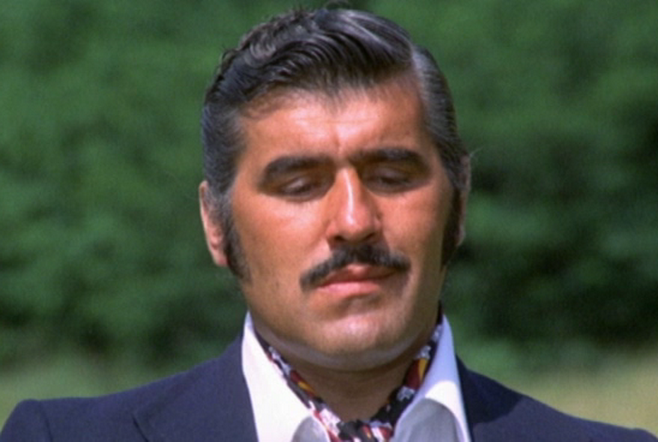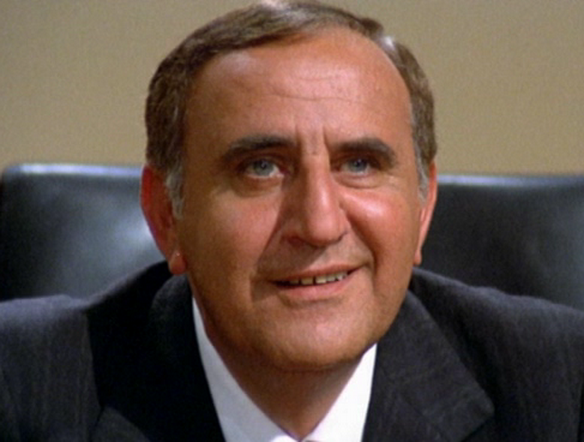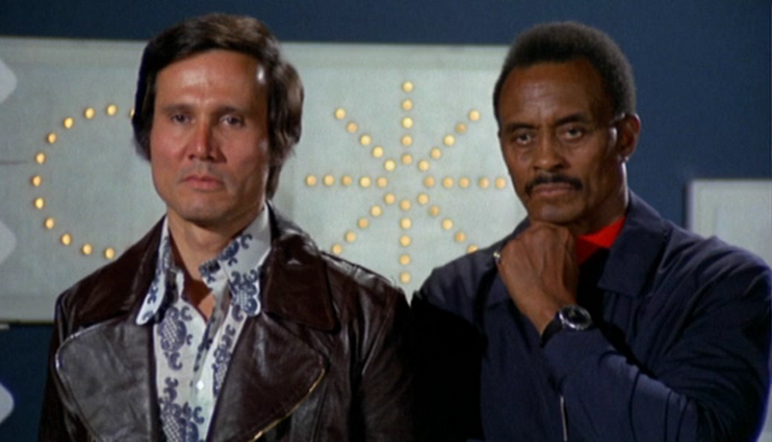
The Italian Connection a.k.a. Manhunt in Milan (O.V. La mala ordina)
Italy, 1972
Director: Fernando Di Leo
Script: Fernando Di Leo, Augusto Finocchi, Ingo Hermes (based on the story by Giorgio Scerbanenco)
Cast: Mario Adorf (Luca Canali), Henry Silva (David Catania), Woody Strode (Frank Webster), Adolfo Celi (Don Vito Tressoldi), Luciana Paluzzi (Eva Lalli)
Music: Armando Trovajoli
Story
In New York, a powerful criminal boss known as Corso summons two of his most efficient hitmen, David Catania and Frank Webster, to his skyscraper. He wants to entrust them with a mission in Italy (since David is of Italian origin and the African-American Frank was a soldier in that country during the IIWW). They will have to locate a certain Luca Canali in Milan to liquidate him; the target must be killed in a spectacular way, so that his death serves as an example and as a warning.
Luca, a small-time pimp, is accused of having stolen a shipment of heroin belonging to the Corso organization. Once in Milan, the two hired killers will have to go to the local boss, Don Vito Tressoldi, to coordinate with him the search for Luca.

The two thugs set up in a hotel and are met by a tourist guide called Eva who knows nothing of their purposes. She is in charge of showing them the places in the city they want to visit. David and Frank want to visit night clubs, as they believe that in the clubs they will get interesting information about the whereabouts of the individual they must eliminate.
Luca has several girls who prostitute themselves under his “protection”. At the same time he is married and has a young daughter. His wife lives separately from him because his occupation disgusts him, but the two have a cordial relationship and meet sporadically, especially because of the girl, who knows nothing of her father’s dishonest work.

Vito Tressoldi is worried about the arrival of the Americans. Although he has a lot of power as the head of the underworld in Milan, he is actually only a subordinate of Corso. The presence of the New York hitmen in his city makes him feel uncomfortable, and he wants them to leave as soon as possible. When David and Frank go to his office to tell him that they want Luca’s head, Tressoldi is more relieved to say that he will collaborate with them in his capture.
At a discotheque, Frank and David talk to a girl named Trini, who reveals the area where Luca moves. Shortly after, Trini (who lives in a kind of hippie commune) calls Luca to warn him that the Americans are looking for him.
When one morning Luca leaves Anna’s house, one of his girlfriends, he is approached by two henchmen from Tressoldi, who “invite” him to accompany them to their car. They take him to a lumber factory on the outskirts of the city, telling him that Don Vito wants to “talk to him”. But once there, they start hitting him. Luca fights back and manages to get away. When Tressoldi and the Americans arrive, they find only the two lackeys beaten. Outraged that they’ve let Luca escape, don Vito executes them on the spot. He wants to show the Americans that he too is serious about catching the pimp.
From that moment on, a veritable manhunt begins throughout Milan. Tressoldi sets up a dense network of informants, and gives orders to locate the fugitive at any cost. Luca is aware of the extent of the “search and arrest warrant” against him, but he does not understand the reason. He tries to seek refuge at Anna’s house, but she rejects him because she wants to avoid trouble. Luca gets hold of a gun, which he buys from a gun dealer friend of his who uses a mechanical workshop as a cover. But this “friend”, seduced by Tressoldi’s money, gives in to the temptation of informing about his whereabouts…
However, Luca once again manages to evade the siege. But he wants to know why he’s being chased, and calls Tressoldi to ask him. Don Vito assures that he only wants to “talk to him”, and that he should come to his offices; but Luca believes that it is a set-up. When Tressoldi notices his interlocutor’s reticence, he blackmails him by mentioning his wife and daughter (saying something like “it would be a shame if something happened to them…”). Terrified, between a rock and a hard place, Luca will try to convince his wife that she and the girl should leave Milan before it is too late…

Commentary
Quentin Tarantino, a great admirer of Fernando Di Leo and of Polizziesco in general, tells us that he was inspired by the two hitmen in “La mala ordina” to create the main duo in Pulp Fiction. Vincent Vega and Jules Winnfield, one white and the other black, have their precedent in David and Frank, the characters of Henry Silva and Woody Strode.
Luca Canali is played by Mario Adorf, whom we already saw in a very memorable (and quite different) role in “Milano Calibro 9” (1972). Woody Strode appears briefly in “Once upon a time in the West” (Sergio Leone, 1968) as one of Frank’s men whom Charles Bronson eliminates in the first scene. With Fernando Di Leo he would work again in “Colpo in canna” (1975), where he would be on screen with Ursula Andress. Henry Silva’s role as a hitman is very similar, as can be seen in other films in which he participates: “Quelli che contano” (Andrea Bianchi, 1974) or the Italian-German co-production “Zinkssärge für die Goldjungen” (Jürgen Roland, 1973). Fernando Di Leo would count on him again for his next film, “Il Boss” (1974), the third of the “underworld trilogy” together with “Milano calibro 9” and this one “La mala ordina”.
The original title of this film (“La mala ordina”) could be translated as “The underworld orders” (“La mala”, literally translated as “The bad one” is an abbreviation for “la malavita”, i.e. “the bad life”, i.e. crime or underworld). As in “Milano calibro 9” we have here a gangster accused of stealing, unjustly or not, from the big organization. Luca Canali has here the same role as Ugo Piazza in the other film; the lone bandit who has to deal with a large and compact group of enemies, and who has fewer and fewer people to rely on.
However, due to the events, Luca will turn from being persecuted into a persecutor…
Don Vito Tressoldi is the head of crime in Milan, but he is intimidated by the news coming from the United States, because there are others who have much more power than he has. Big shots like Corso are furious about the theft of their merchandise and Tressoldi fears that they actually suspect him. At the same time, he discovers that he had underestimated Luca.
This time the soundtrack is not composed by Master Bacalov but by a certain Armando Trovajoli. The music, very seventies-like and with repetitive melodies based on saxophones, is not as remarkable as in “Milano Calibro 9”.
“La mala ordina” cannot be considered strictly a polizziesque, since not a single policeman appears during the footage.
Although it is undoubtedly a good film, “La mala ordina” is in my opinion the weakest of Fernando Di Leo’s famous “underworld trilogy”. I consider both “Milano Calibro 9” and “Il Boss” very superior.
Get Mafia Films: A Guide HERE!
Get The Italian Connection HERE!
(This is an affiliate link. I may earn a commission if you purchase through these link, at no extra cost to you. As an Amazon Associate, I earn from qualifying purchases.)
Get Fernando Di Leo Crime Collection 4-Disc Box Set HERE!
(This is an affiliate link. I may earn a commission if you purchase through these link, at no extra cost to you. As an Amazon Associate, I earn from qualifying purchases.)

Pingback: Il Boss – Fernando Di Leo, 1973 - fhpbooks.com The Boss 1973